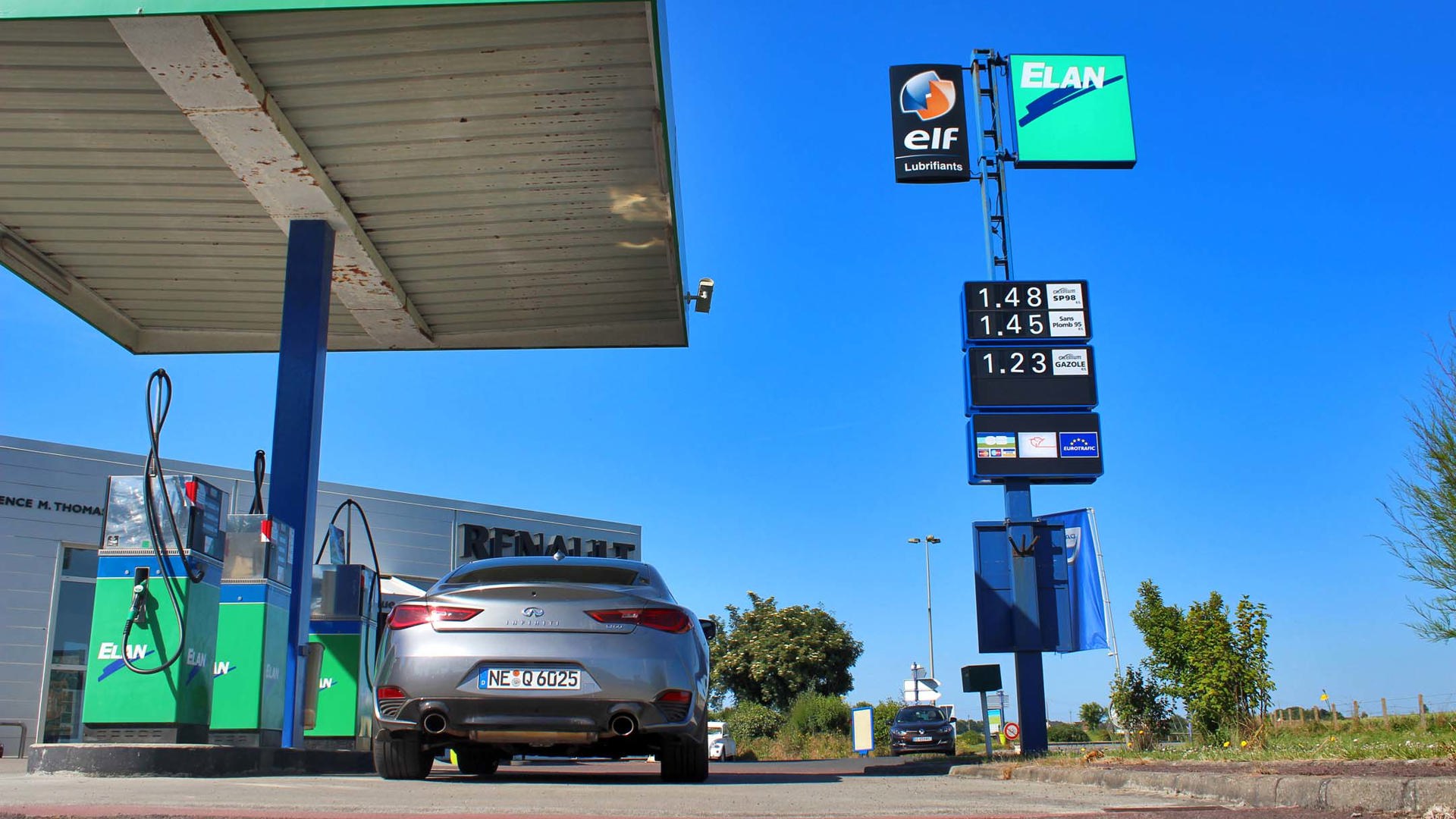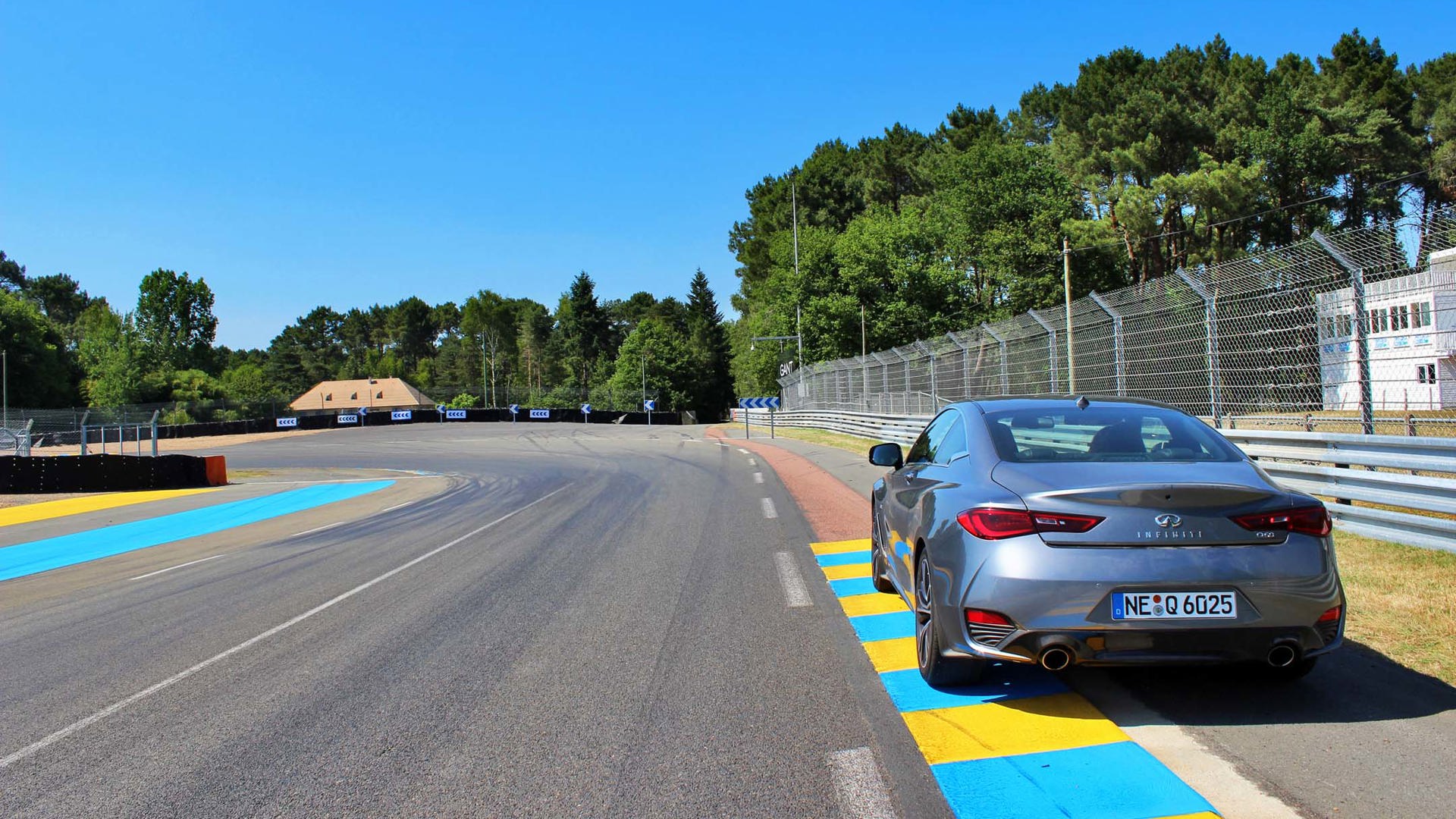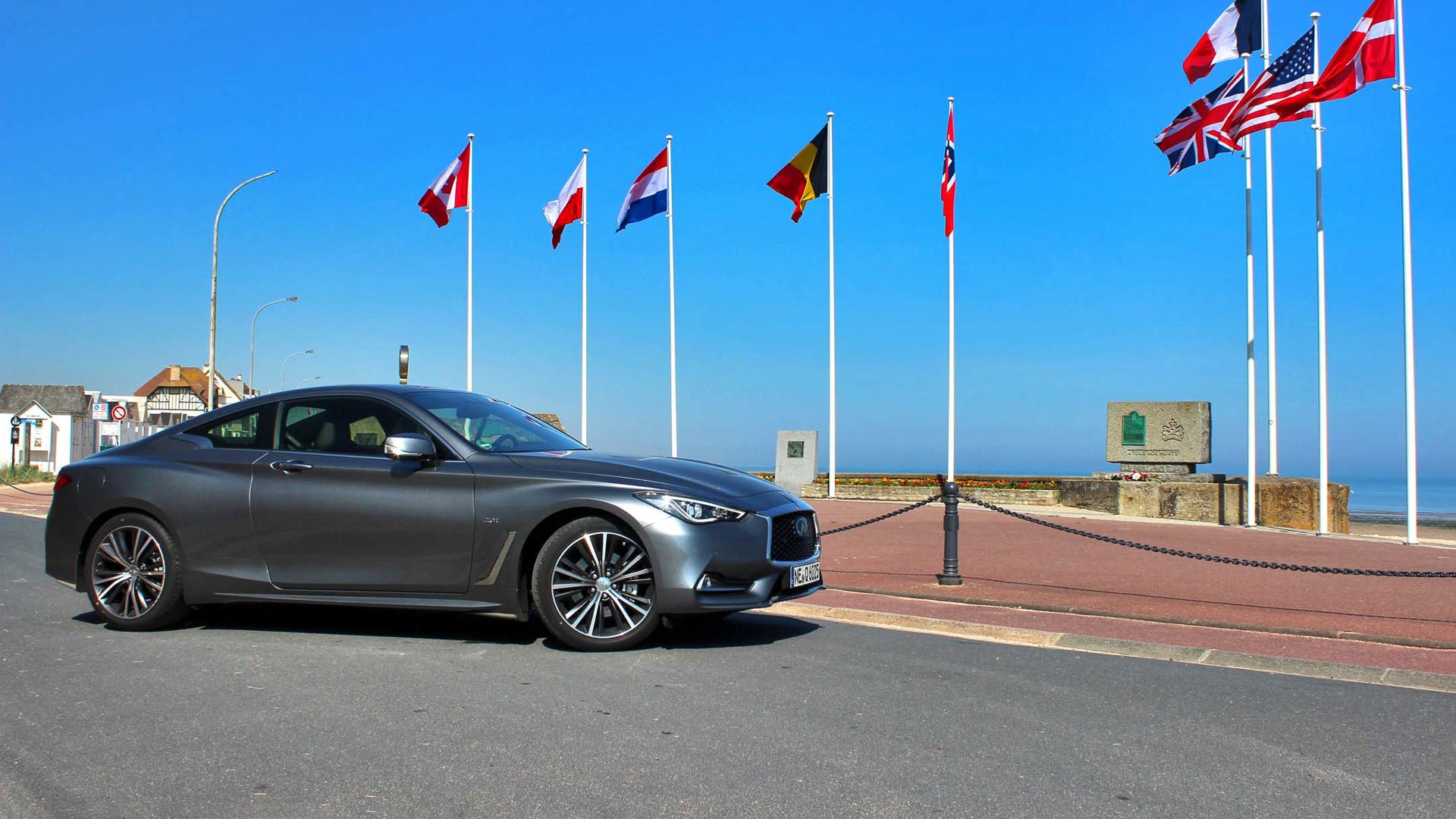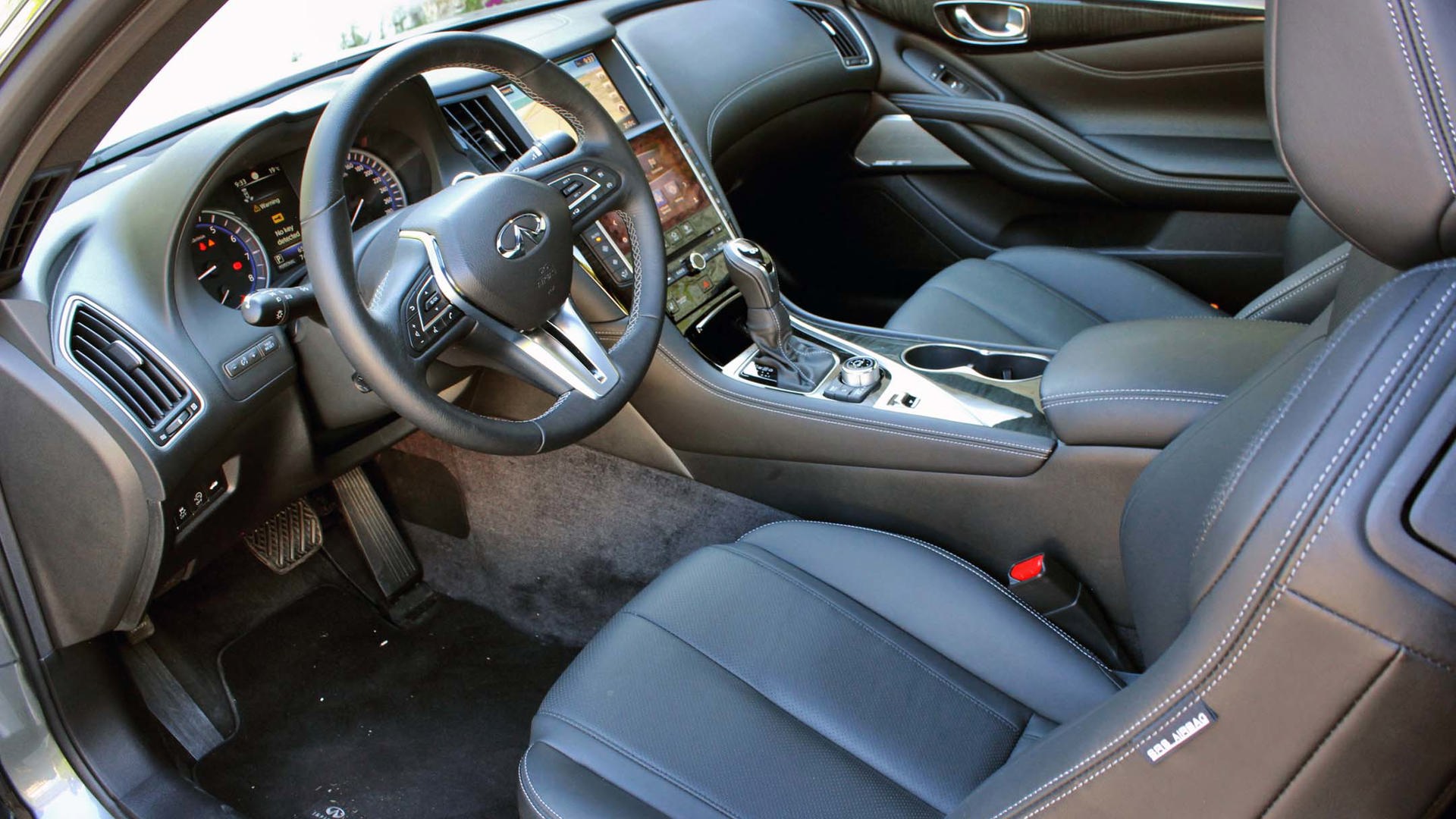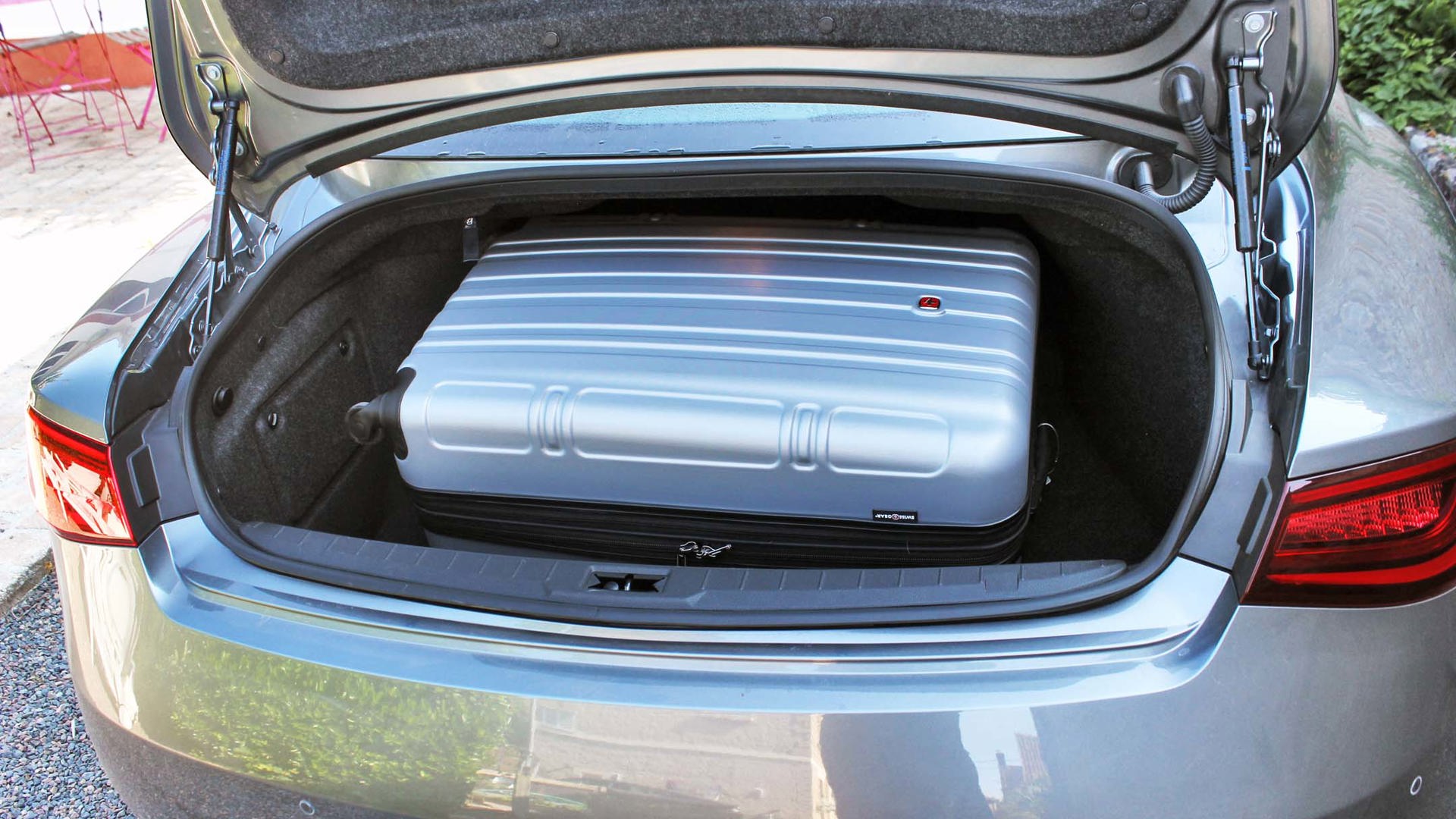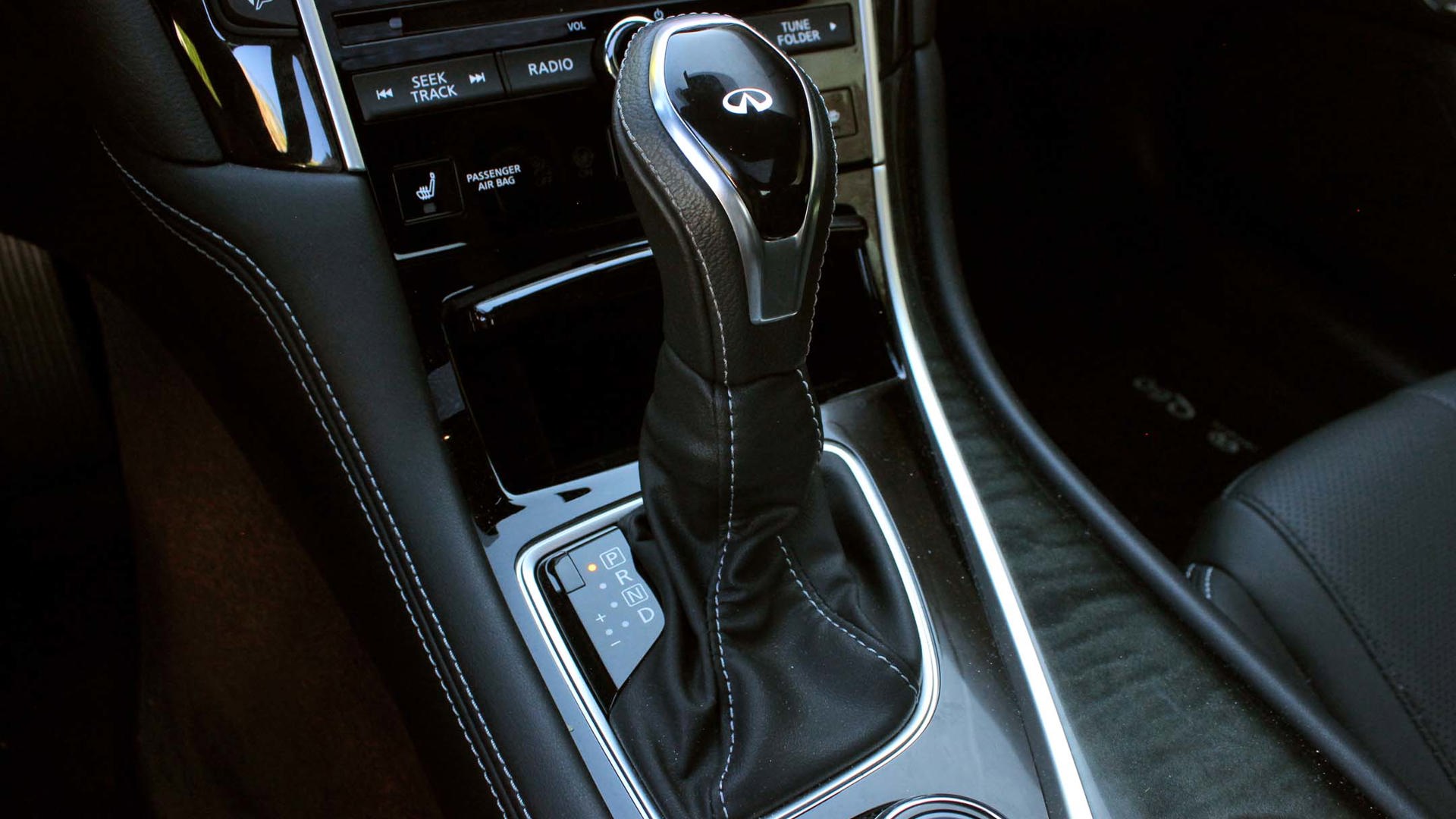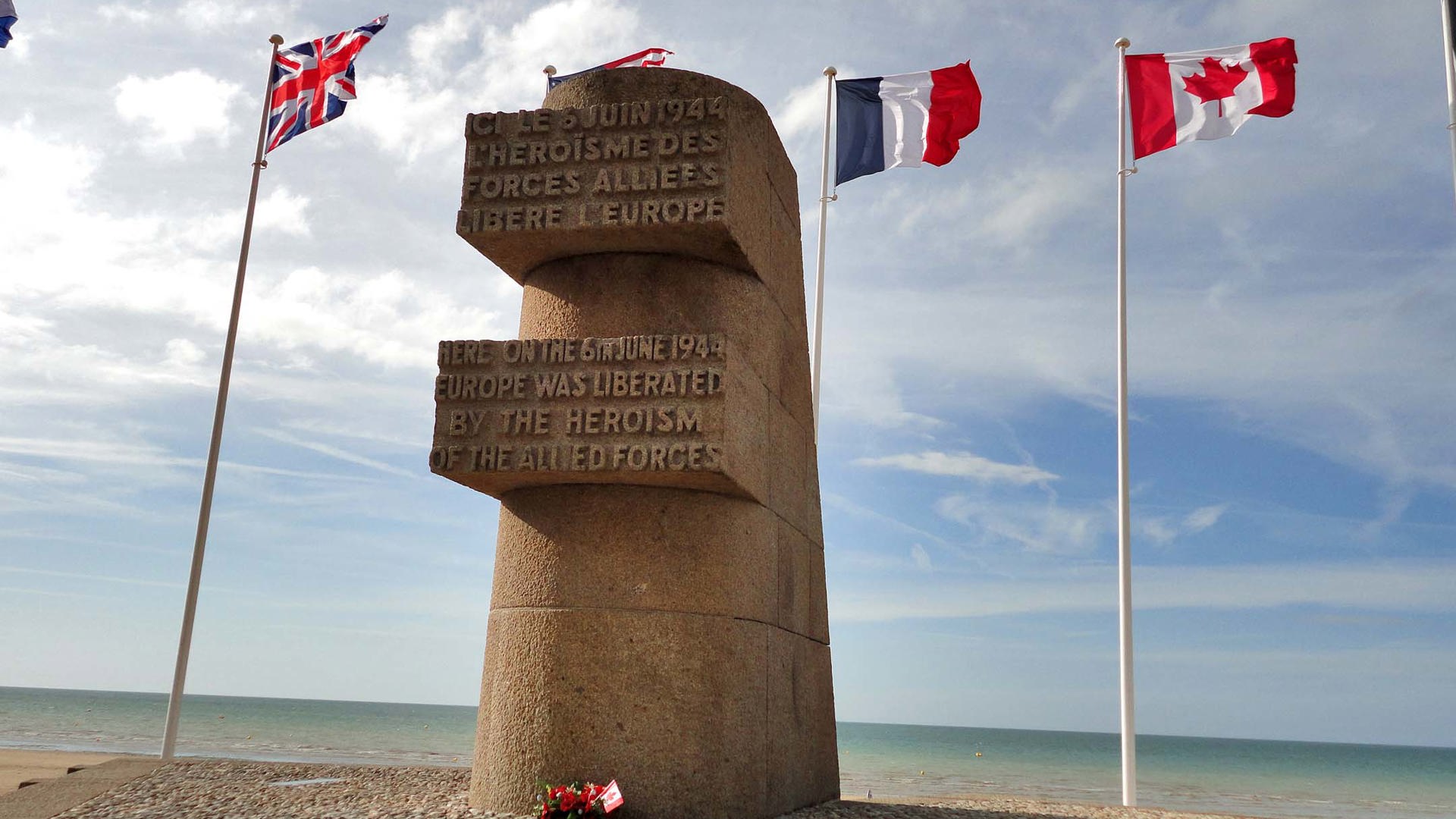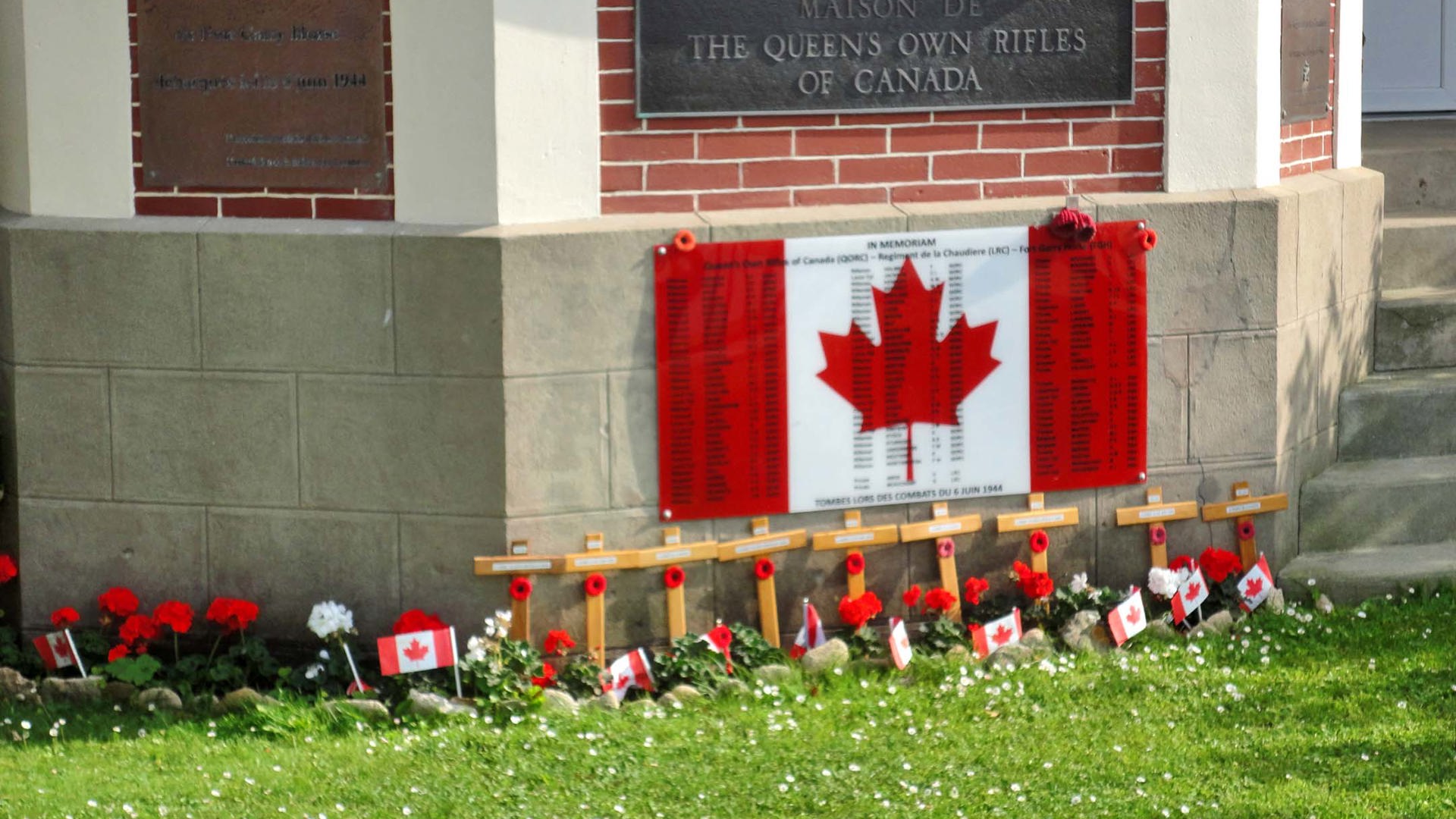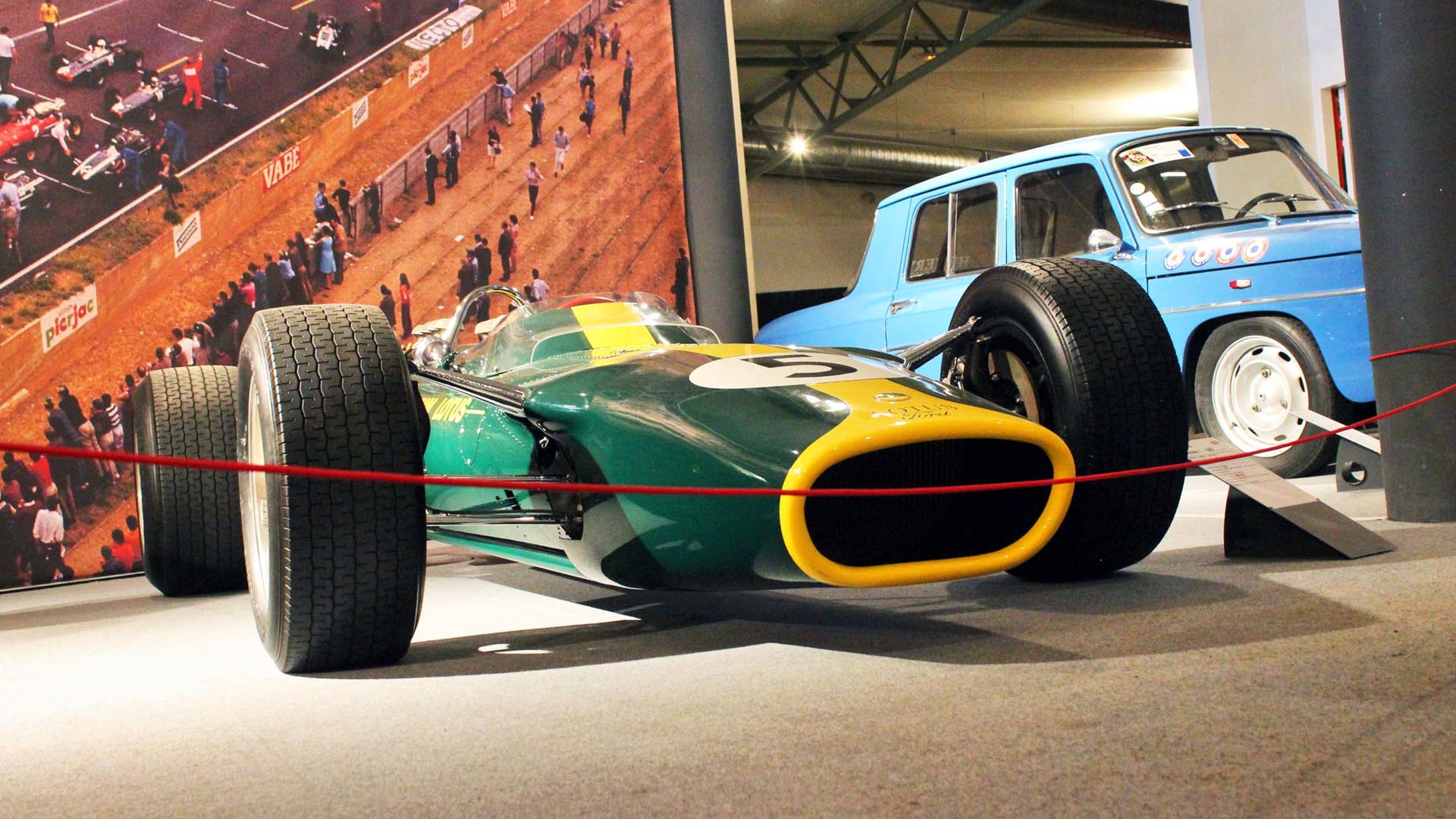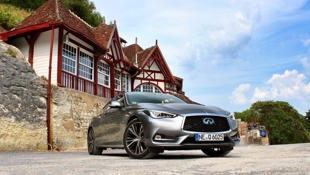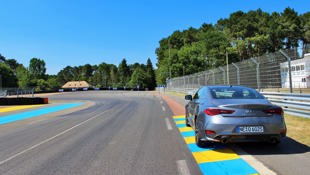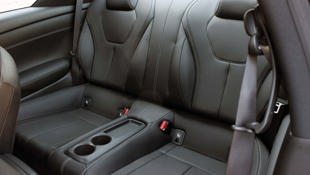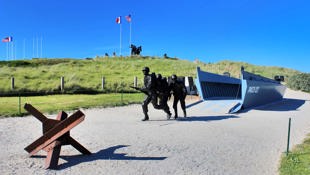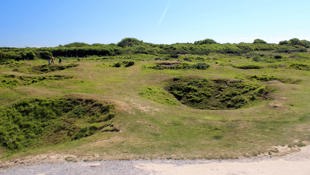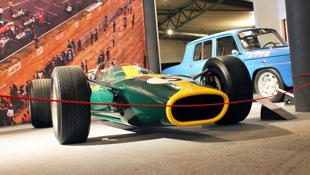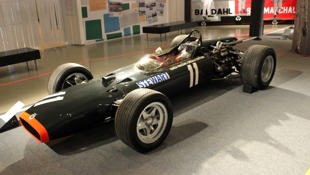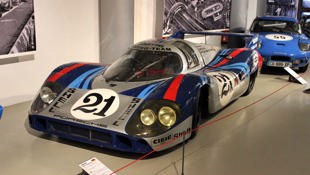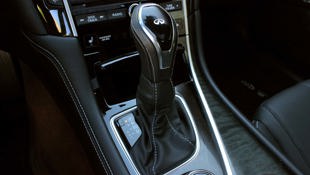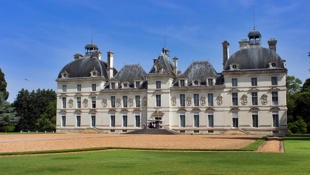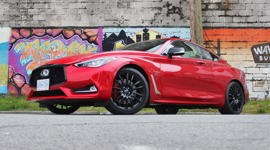There are many hatchbacks in France. Two-door, five-door, three-door – the big three French manufacturers – Renault, Citroen and Peugeot – seem to have a dozen models each, and that’s not including the high-roofed variations each of the dozen seem to have.
A Q60 on the coastal roads of France is about so much more than the narrow passages.
I’ve always thought I understood why this would be, but until you experience it in a tiny beach town on the Normandy coast, you really don’t know. After spending the better part of a week here behind the wheel of the 2017 Infiniti Q60, I do.
The Q60 is not an especially large car, at least not by North American standards. Here, however, it feels massive. Every alley – they’re technically roads, but their circa-1700 width is such they may as well be alleys – in small towns like Bernières-sur-Mer seems to allow parking on both sides. And while most Europeans drive hatchbacks, many drive vans. Big, wide vans adorned with names like “Iveco” and “Skoda”. And they park them, right there, barely on the side of the “road”. Which, of course, means this silly Canadian tourist and his bulbous (by French standards) car is going to be folding his power mirrors while on the move. A lot.
But we’re getting ahead of ourselves. A Q60 on the coastal roads of France is about so much more than the narrow passages.
Parisian style
While the first half of our trip was to be spent in Paris, parking a car in that city is prohibitively expensive and when your common obstacles switch from tight alleys to slightly-less-tight roads crowded with maniacal French lorryists and scooters, well, let’s just say you become less inclined to drive. The city is great – one of my favourites – but a nice city does not necessarily a fun drive make.
That’s especially the case when the car you happen to be driving is an all-new sports coupe from a manufacturer that has a history of making some darn fine sports coupes.
While we’ve seen the badge on Infinitis before, the Q60, in its current 2017 form, is all-new. It’s no longer a re-skinned G37, which originally resulted from Infiniti changing their entire model nomenclature and being forced to hastily whip something up for a car that wasn’t yet ready to be replaced.
They’ve replaced it now though, in spectacular fashion.
Spectacular to the point where the styling looks right at home in France, where the cars you see from domestic manufacturers – and you see a lot of them – tend to have a little more style, a little more panache. The headlight lenses on a Citroën C6 from the mid ’00s, for example, are unlike anything you’d ever see in a domestic equivalent – say, the Chevrolet Impala – of the same era. The stance of the full-size Peugeot 407 is actually somewhat imposing when seen in your rear-view – especially since drivers of these seem to love to ride your bumper an exorbitant amount, even by French standards – that you have to look twice to realize it’s really just another executive saloon. And the Renault Talisman, cousin to our Infiniti? Forget about it. It may be used as a livery vehicle, but darned if you’ve ever seen a Town Car look anything like this. Those are just the big sedans; I challenge anyone to look at a Peugeot RCZ and not think that while it’s a bit of a copycat of the Audi TT, it’s actually the better-looking of the two.
Did our plucky Infiniti coupe fade when placed amongst these esteemed examples of French automotive art? Quite the opposite, in fact.
It helps that rather than just go toe-to-toe with its competition here in Canada, it actually blows them out of the water in the styling department. The BMW 4 Series, for example, is handsome to be sure, but you know BMW doesn’t want to upset the 4 Series’ massive buying public with too many glitzy styling additions. The C-Class Coupe is also quite the looker, but the Q60 just edges it thanks to a tantalizing mix of old-school, traditional lines (long hood, cab-rearward design) plus some very 2017 elements, such as aggressive headlamp lenses, one of the proudest grilles on the market this side of Audi and Lexus and that great take on BMW’s iconic Hofmeister Kink ’round the rear side windows.
Is it a little too extravagant? Not on these roads, it’s not.
Every highway feels the same
Of course, all the extravagant styling in the world isn’t going to make up for the fact that the first leg of our journey – Paris to Bernières-sur-Mer, a coastal village in France’s Normandy region with some significant history about it – is a pretty boring one. Autoroute 13, which cuts an east-west swathe through upper France from Paris to the coast, is not an especially enthralling experience, more akin to the slog from Toronto, ON, to Montreal, QC, than it is to the coastal roads on the Côte d’Azur, at the other end of France from where we were going.
It did, however, give us the chance to experience one of France’s highway system’s great attributes: the 130 km/h speed limit. It was big news when some portions of the Coquihalla pass in BC got the 130 tag, but France, it would seem, has been doing it for years.
It seems that way because traffic flow is such that the high speeds seem completely natural; drivers respect the speed, it’s well-signed – more on this in a minute – so you know exactly what your limits are and god forbid you should sit in the left lane if not passing; you’ll understand what I mean as soon as you see yet another Citroën hatch on your rear bumper as you lope along at a mere 123 km/h in the fast lane. He’s flashing his headlights – that means get out. Get used to that, and the French highway experience is a very good one.
Right, the signs. Put simply, there are a ton of them. Highway exits typically have four sets or so; two displaying your speed limit – usually between 70 and 90 km/h – two square blue signs adorned with a white car being crossed out, denoting the end of the highway, two “no left turn” signs once on the ramp, and typically, another sign to show you that you’re re-joining another road. It’s as if France’s highway commission still hasn’t got away from the paranoia surrounding WWII’s Vichy government and wants to ensure that every possible base is covered at all times, and that means holding a motorist’s hand whenever possible.
Those are just the exits; don’t get me started on the signs reminding you what region you’re in, the signs painted with scenes depicting what to expect from the various towns accessed by the next exit, and the square blue signs with down-and-right facing arrows, first denoting the arrival of a median, then a round one denoting that the median is now ending. Wanna make some big bucks? Get into the French road sign business. You’ll make a killing, I guarantee it.
Rouen
Our first stop before our final sprint to our coastal cottage had us in the town of Rouen.
In modern times, Rouen was a WWII hotspot but it’s better known for what happened there during the Hundred Years’ War. You see, it’s the place where the great Joan of Arc met her demise after being convicted of heresy. There’s a great memorial museum for her there, as well as not one but two great cathedrals, one of which is a pretty stark mix of styles as it was constructed over such a long period of time that the two main towers are different since one was financed by people wanting to eat dairy products during Lent; their donations of a few coins to the church eventually meant it could afford to build an even bigger tower.
Other than that, Rouen features a funky shopping district that intermixes McDonald’s and Coach with oh-so-classic “Tabac” shops and stores where you can buy everything from die-cast models of cars made famous in the Tintin comic book series (that’s 50 euros per, mon chéri) to entire horses from old merry-go-rounds. We kid you not; they’re right there in the display windows!
Back on the road, we got the chance to once again experience those lovely 130 km/h zones, courtesy of a car that is surprisingly adept at handling them. I say surprisingly because ours was the entry-level four-cylinder turbo version (208 hp, 258 lb-ft of torque), and it gives away quite a bit of power to the two V6 Q60 models available elsewhere in the line-up.
It does its business a little noisily under hard acceleration, but it has no trouble getting you there and beyond, a testament to what a well-implemented turbo motor and slick seven-speed automatic transmission can do when properly aligned.
Said engine noise, meanwhile, is really the worst of it when it comes to intrusive sounds allowed by the Q60. Its slick shape means wind noise is reduced to a minimum, the cabin is well insulated, and apart from a few jaunts on some older tarmac, road noise remained pleasingly low, too. Couple all that with roomy front seats that are a great mix of comfort and support, and you’ve got quite the grand tourer in your hands.
Pay to play
The long straights of the A13 also gave us the chance to experience the Q60’s comprehensive set of active driver aids; we made good use of the adaptive cruise – adjustable to three levels of distance from the vehicle ahead of you – as well as lane-keep assist, which subtly keeps you on-line if you begin to drift out of your lane without bouncing you back and forth between the lines. Great stuff.
The final fun detail that we first got introduced to on A13 is the omnipresent existence of toll roads. It seemed that every 10 clicks, we’d be getting the “there is a toll ahead” notification from our navigation system, and by the end of it all, we’d spent almost 100 euros on tolls alone. Arriving at a toll booth is one thing (be ready, however, for the motorist ahead who inevitably decides at the last second that the lane you’re about to enter is moving faster, and deems it safe to just dart right in there juuust as you’re arriving to the gate); the real adventure is leaving the toll booth, when as many as 10 lanes, for all intents and purposes, converge into two and maybe three. It’s a scene, man. Best watch those mirrors.
Final toll paid and final kaleidoscope of signs passed (and final roundabout; even more common than “toll ahead” from our navigation was “in 50 metres, there is a roundabout”) just outside of Caen, once levelled by war and hurriedly re-built, and we were on our final stretch, otherwise known as D79A, to our destination.
It was here that our road trip really came into focus, that we finally felt like we were driving through a pastoral French setting as opposed to an expressway artery that could’ve been anywhere.
Fantastic pastures dotted with round hay bales as far as the eye could see, low, stonewall farmhouses made all that more magical by the fact many had lived through two world wars, and most importantly, a sinewy stretch of tarmac winding its way to the English Channel beyond, and seemingly the horizon beyond that. Maybe it was the fact the sun was low and golden. Maybe it was the fact that it was such a stark contrast from the low-rise business park that is Nissan’s Western Europe HQ just outside of Paris. Either way, the sense of bliss was palpable, and we knew the next few days were going to be special.
History and heritage
As mentioned before: Bernières weaves a much richer historical tapestry than its humble surroundings full of classic boulangeries and churches suggest. It’s an important tapestry, it’s emotional, and it’s one that we Canadians especially must not forget.
You see, Bernières-sur-Mer resides just off of Juno beach, where the Canadian and British forces landed on that all important day in June of 1944, D-Day.
Our visit this year seemed especially appropriate, what with Canada’s 150th anniversary celebrations and all; it seemed appropriate to visit the battlegrounds where men and women fought to ensure we have the life we do today in our beautiful country. 14,000 young Canadians charged out of Higgins boats and up to the beachhead, steered tanks, and flew aircraft that day; the platoons arrived in geographical order, with the Princess Mary’s Canadian Scottish Regiment out of Vancouver Island landing first, followed by, among others, the Regina Rifle Regiment (RRR), the 1st Hussars out of Sarnia, The Cameron Highlanders out of Ottawa and so on; only Saskatchewan and Manitoba swapped, with the Royal Winnipeg Rifles landing before the RRR.
Eventually, 90,000 Canadians would pass through here and into France, helping liberate the country and with it, providing a gateway to eventual victory over Nazi Germany.
In Bernières, among memorials like the Canada House – German soldiers tended to shack up in civilian homes, and this was reportedly the first house on French soil liberated by the allied forces – the flag arrangements and more, you can still see curbs that were crushed by allied tanks as they arrived in the village. The still-standing German bunker just past Canada House serves as a reminder of just what occurred here.
That, of course, is just a small portion of the WW2 sights you’ll find in the area. After a day spent perusing the spectacular Mont Saint-Michel island abbey – you’ve never quite seen an omelet like that which is served at Madame Poulard’s, on the island’s main drag – then visiting the picturesque fishing village of Honfleur, where the houses are narrow because they were designed and built by fishermen, more accustomed to the narrow environs of their boats (it also happens to be the last town before you cross the Normandy Bridge, the western world’s largest cable-stayed bridge) we returned to the WW2 sights, starting with the almost surreal Point-du-Hoc (PdH).
You might say that this was the epicentre of the US forces’ assault on Normandy, just off of Utah beach. The craters and bunkers that have been left there have to be seen to be believed; it’s strange to be standing in the middle of what appears to be a peaceful meadow, surrounded by the grassed-over remnants of shell after shell.
A similar thing can be said about Arromanches, just down the road from PdH; there, the allies had to construct a makeshift floating port to ensure they could continue to provide the forces on land with the necessary equipment and supplies as they pushed further into France, then Belgium, and beyond. At low tide, you can walk right up to the massive concrete platforms originally used to support the port. They’re gigantic and eerie monoliths that serve to remind you that this picturesque beach – and amongst all of the rest of this, it needs to be said that all these beaches are very pretty – was once a very, very different place. And it’s everywhere you look; a memorial over there, a museum over here – the allied war effort is celebrated, to the point where war-era Willys MB Jeeps are still being worked on in garages alongside modern day Renaults, as we saw in Villers-sur-Mer.
We finished the day with a visit to the American Cemetery, trying and recover from the mass of information and emotions we’d been dealing with all day. A stop by one of the many apple orchards for a refreshing bottle of apple cider hit the spot; France may be best known for its fine wines, but the crispness of the various ciders and the surprising smoothness of Calvados apple liqueur deserves honourable mention, that’s for sure. Oh, and don’t forget a wheel of Camembert cheese; the variety started just a little inland from where we stood.
So it’s safe to say that after those epic few days in the region, we were looking for something a little more easygoing as we prepared to head south from Normandy towards the much-chateau’d Loire Valley region.
Luckily for us, the town of Le Mans just happens to be on the way.
Highways be damned
Sick of paying tolls, we decided to start our drive on some 1-800 roads (because they’re toll-free, right?), which had a bit of a dual effect.
First of all, they’re off the beaten track and on the coastline, meaning stretches in between towns not as pockmarked with WWII sights. It was along these twisty roads that we got the chance to experience what I thought would be one of the highlights of our particular Q60: it was a rear-wheel-drive model and I figured that coupled with the lighter front end, it would be quite the handler.
As it turns out, that’s somewhat true, if not all the way. You see, Infiniti has employed their drive-by-wire steering system, meaning the front axle doesn’t form a direct connection with the steering rack. Instead, there’s an actuator clutch that senses a driver’s inputs, and proceeds to communicate said inputs to the front axle at something like a million teraflops a second or whatever [The unit is hertz. – Ed.]. It allows both the steering weight and responsiveness to be adjusted automatically on-the-fly (or by the driver through a slick touchscreen interface). It works well in that regard as the changes can really be felt.
Problems arise, however, when you begin to consider the steering feel, or, I should say, the lack thereof. No amount of electronic trickery is going to make up for that and the result is some frustratingly spongy progress. Still, all I had to do was keep reminding myself of our destination, and any steering issues I had melted away like hot butter on an artisanal French baguette.
Le Mans
I often have trouble remembering that Le Mans is, in fact, the name of a town, and not just a world famous race known for its punishing 24-hour length – and the fact that a big part of it is run on public roads, worn down by DAF lorries and Mercedes-Benz buses.
Which is where our adventure comes in. I’ve always loved Le Mans, having visited twice prior (once to the race, once just to visit) and turned about 1,000 laps on the track in the Forza Motorsport videogame series and darned if I wasn’t about to unleash the sportiest of Infinitis on its hallowed tarmac.
Thing is, they’d just finished running the race a day before we’d arrived, and I was worried that the roads on which it runs – one of which, D338, is otherwise known as the Mulsanne Straight – would still be closed. As we arrived at our starting point – the Musée des 24 Heures du Mans – my fears seemed to be confirmed; there was a sign on the door that said tours of the track were closed that day, which to me said one thing: you’re right outta luck, pal.
So, needless to say, I approached the nice lady at the museum’s front counter with trepidation, preparing to say the words in French I’d been practising ever since Deauville (more great beaches there, by the way; it shouldn’t be missed): “Est-ce qu’on peut conduire la course aujourd’hui?” Which, loosely translated, says, “Oh Le Mans Lady, please God tell me the course is now open….”
“Bien sûr! Dès 1600 heures Dimanche.” Which, loosely translated, says, “Duh. It’s been open since Sunday. Because, y’know, we need these roads and that’s when the race ends.” Turns out, the sign on the door was referring to private guided tours of the part of the track that’s not on public roads.
However, because I guess I’m a bit of a glutton for punishment, I wanted to get the juices flowing even more. Which, of course, meant a tour of the museum itself had to happen first.
Now, while it’s not quite as dripping with lore wall-to-wall like, say, the Ferrari museum in Maranello where I did my last European excursion, you know you’re on some pretty sacred territory, amongst some pretty sacred autos when you’re here.
The weird part about our particular visit, however, was that the first gallery (the tour is a pretty linear one, which I rather like) you enter is actually a temporary exhibit and this year, it had nothing to do with the GT cars and prototypes that have always run here; instead, we found a gallery of circa-1967 Formula 1 cars, 2017 being the 50th anniversary of the one and only time the French Grand Prix was run on the secondary Bugatti Circuit here at Le Mans. What a stroke of luck! I’d been to the museum before, so it was nice to see something I hadn’t previously. Let me tell you: the classic Lotus 49 in all its British Racing Green glory is a lot smaller than you think. These things really were cigar cases with wheels, and since the bodywork was so minimal, the engines are right there in plain view more than they ever would be today and by God, they are gorgeous.
The next room was another surprise. Acting like the hub around which the rest of the exhibits rotate, it is loaded with 1:43 scale die-cast models of all the most important racers that had contested Le Mans from 1950 to 1990. All the winners are here, along with notable entries like the Porsche 917K, Alpine A442 and Matra-Simca MS670B; even eclectic entries like the WM-Peugeot P88 – it still holds the top speed record at the track, 407 km/h, set in 1988 – and the “Pink Pig” 917/20, circa 1971. Not only is it a die-cast lover’s dream, it’s a great look at the evolution of the Le Mans racer. Needless to say, I returned to the “hub” numerous times during my visit, much to the chagrin to my oh-so-patient wife and travel companion.
After a quick perusal of the non-racers exhibits there which include a track fire truck and a S.E.V. Marchal lighting truck adorned with more light fixtures than Home Depot, it’s time for the big cheese: the last hall, if you will, features some of the most famous cars to ever compete here: Porsche 917LH, Peugeot 905, Mazda 787B – how they pried the actual race winner away from Mazda HQ is a great mystery – all the way up to recent stuff like the Audi R18 e-tron Quattro. I could’ve spent hours in here, photographing every detail. Maybe one day I will.
For now, however, we had a “race” to run.
On Track
It’s not as if you pull out of the museum parking lot and are immediately on the track; a few more roundabouts do have to be negotiated in order to do so. As hard as Nice Le Mans Lady tried, we couldn’t quite find it the first time… until we did.
You see, it kind of sneaks up on you, the Mulsanne, and that’s what’s so special about it. To the untrained eye, it’s just a tree-lined major artery. Then, however, you see the Partedis Yvon lumber yard on your left, and you say to yourself “I’ve seen this before”, and then it dawns on you: you’re driving at Le Mans!
It’s incredible, it really is. Even limited to 90 clicks (and we were warned that we’d better strictly adhere to that, or else), the thrill is real, just knowing that your tires are scrubbing the same curbs as the Porsche 919s and Corvette C.7Rs were not 24 hours before. You settle in, close your eyes for a millisecond and try and imagine what it must be like, hammering along this thing at 3 am in the morning in the rain (most years it rains; not this year, however). What’s interesting is the chicanes that were added in 1990 are only for the racing cars – you can see them, but they’re gated – so part of the track that you’re actually driving on is something only civilians get to do. Crazy, right?
The feeling really hits home, however, as you reach the end of the Mulsanne straight and approach the Mulsanne corner, which is basically a hairpin and had been the bane of my virtual race driver existence for years. After that, you come to the Indianapolis, then the Porsche Curves – all of it. You don’t need to considering the relatively tame speeds you’re doing, but it’s fun to try your best to place the tires on the racing line – baked permanently into the tarmac and curbs – even if you know the guy in the red Ford Transit behind you is rolling his eyes in a “Here we go again. Yet another tourist trying to ‘perfect his line’” manner. No matter – all I know is it’s like saying “I was here. I did this.” and I would do it again. In fact I did, just to make sure I wasn’t dreaming. Nope. All real. Experience of a lifetime.
Turning for home
Indeed, it was going to make it tough on the final stop on our journey to stand out. The Loire Valley region – while beautiful and home to quaint wineries and not-so-quaint chateaus that were put up as regimes got conquered, got pushed back, and conquered again – isn’t exactly a motoring mecca.
Still, I was glad we visited as it was a nice, relaxing way to end our journey. Need a break? Take a walk through the award-winning gardens at Chateau Chaumont, home to an international garden competition that changes the grounds every year. Or, make your way to the spectacular Chenonceau castle, half suspended over the Cher river. My highlight? The Château de Cheverny, which remains inhabited by the sixth generation of the family that originally started it. It also happens to be the castle that inspired famed Belgian comic book artist Hergé to create Marlinspike Hall, which makes numerous appearances as Captain Haddock’s home in the famous Tintin comic book series. There’s even a small museum on-site that actually put you in certain famous scenes from the books.
At this point, however, we had covered a lot of ground, and it was time to plan our trip back to Paris. Over a couple of glasses of fine Loire rosé in our bed and breakfast, we were given the chance to reflect on just how far-reaching the trip had been. The truly fascinating part was that while our odo read over 1,600 km, much of that was spent weaving in and out of familiar areas and we really only saw a small slice of the country.
How densely packed the area was, however, gave us the most pause. From memories of world-shifting events long ago, to the mecca of the race car and culinary delights, there is so much in this area that we felt like we’d only scratched the surface. We encountered many a raised eyebrow when we mentioned that our trip through France wouldn’t be taking us to the south of France – seems that some people think that’s really all there is to see, this side of Paris – but by the end of it all, we knew we’d made the right decision.
The car? It had acquitted itself well, even after the sheen of those great curves had been dulled by miles of dust. We were always happy to be returning to it; it helped that the climate control system was a fast-acting one, considering the 40 degree temperatures we were dealing with during a heat wave at the end of our trip. The engine pulled when asked but wasn’t too thirsty – we saw 8.8 L/100 km, good considering the EU’s steep gas prices – the cabin is a comfortable place to be, and those driving aids really made the longer Autoroute drags that much more pleasant. This was grand touring at its finest, and the Q60 answered the bell. And it doesn’t even have a rear hatch.








